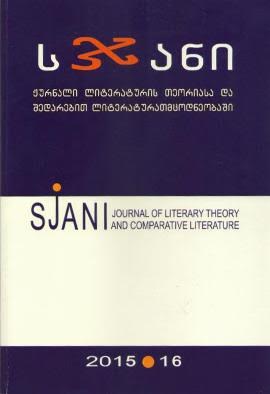Жанровая матрица антивоенного романа и
современная литература
Anti-war Novel Genre Matrix and Contemporary Literature
Author(s): Kateryna GurdusSubject(s): Literary Texts
Published by: ლიტერატურის ინსტიტუტის გამომცემლობა
Keywords: anti-war novel; genre markers; genre matrix; pathos; poetics.
Summary/Abstract: The paper is devoted to the study of anti-war novel as an artistic-aesthetic phenomenon,the analysis of the existential discourse of antinomy war / peace in science and literature as an art form.The problem of genre name and its literary comprehension is touched. The question about the theoretical definition and recognition of anti-war novel as a term is raised because of its ignoring in directories, dictionaries, encyclopedias and other literary editions,despite nominative evidence and the use in practice of fiction analysis.The place of anti-war novel in the genealogical hierarchy of literature is defined,in particular its correlation with such categories as military literature, military prose, antifascist novel.Anti-war novel is considered through the prism of the classic novel genre’s signs, in particular the scale of the depiction, the complex structure, broad spatial-temporal boundaries and extensive image system. The major stylistic components of the anti-war novel’s genre matrix are analyzed more detailed. Special attention is paid to the anti-war pathos as defining genre marker and the concept of war as an art rod which structures works,depending on their topical vectors and determines the deployment of the story in one or another meaningful plane. The other differences of genre (battle scenes, naturalistic descriptions, elevated lyricism, realism etc.) and the most used techniques or artistic reality modeling resorted by the authors of anti-war novels (introspection, retrospection and anticipation) are also examined.Anti-war novel appears as a contaminated genre structure, which can combine one or more additional genre dominants at the level of content, chronotope, subjects, that means it can simultaneously be social-psychological, philosophical, historical, adventure,fantastic, urban, marinistic, novel in short stories, poems, letters and others.Theoretical comments and generalizations are supported by examples from world literary history. The origins of the genre as part of the military literature are traced in the heroic epos. The epopee «War and Peace» by L. Tolstoy is distinguished from the author’s literature in the context of obvious influence on the emergence of the anti-war novel. The fundamental basis of the studied genre system is seen in the novels-anticipation, novels warning of war by H. Wells, Jack London and others, and also in the first anti-fascist novel«Man of Straw» by H. Mann.It systematized waves of the formation of the anti-war novel. «Under Fire» by H. Barbusse is called as one of the earliest responses to the events of World War I. There has also been monitoring a new wave of interest in war / anti-war theme in the literature ofЖанровая матрица антивоенного романа и современная литература108 the late 20-es of the XX century, which is conventionally called the interwar period of the development of anti-war novel. The works of this time «All Quiet on the Western Front»by E. M. Remarque, «Death of a Hero» by R. Aldington, «A Farewell to Arms!» by E.Hemingway are presented as textbook examples of the genre. Special attention is given to the second military period associated with numerous works comprehending the tragedy of humanity in World War II. New waves of anti-war novel formation are associated with events in Vietnam, Afghanistan, Chechnia etc. Numerous examples of novels-sequel that have become parts of the anti-war diloguees, trilogies and other cycles of anti-war prose are also given. It presents various examples of the genre in literature of the Western European countries and also the USA, the former USSR and others.Features of artistic interpretation of the anti-war genre in literature of the post-Soviet space are analyzed on the example of provocative novels «War’s Unwomanly Face», «The Boys of Zinc» by S. Alexievich, «A Journey to Karabakh» by A. Morchiladze, «Whenthe Doves Disappeared» by S. Oksanen, in which the authors dared to touch many of the forbidden pages of history. A separate place is given to the consideration of the Ukrainian anti-war novel since the classics till the latest models, including «War and We» by S. Pantiuk, «The Book of Oblivion» by V. Slapchuk, «Free World» by T. Belimova and many others.Analysis of the brightest examples of anti-war novel became the basis of claims for non-exhaustion of the genre and its powerful artistic potential in modern cultural space.Prospects for further development of anti-war novel are foreseen in a deep understanding of war as a potential threat not only to individual countries and their inhabitants, but to mankind in general, in the assertion of peace and life as the highest human values.
Journal: სჯანი
- Issue Year: 2015
- Issue No: 16
- Page Range: 93-109
- Page Count: 16
- Language: Russian

